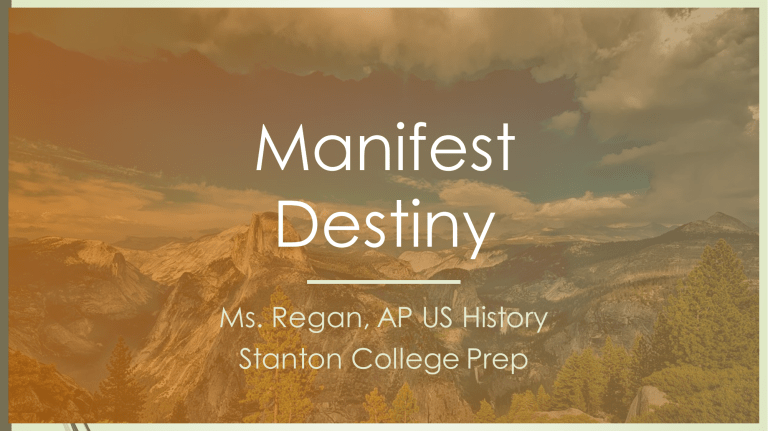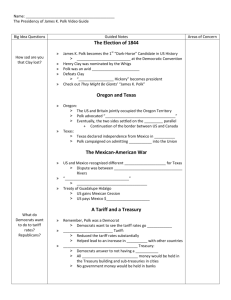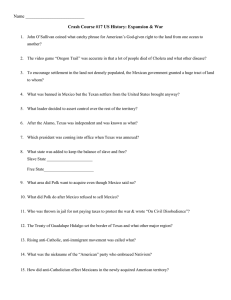
Manifest Destiny Ms. Regan, AP US History Stanton College Prep 2 William Henry Harrison 9th President of the U.S. Whig party member and was not seen as a very strong leader. Daniel Webster (Secretary of State) and Henry Clay (leader of the Whigs in the Senate) saw an opportunity to control the presidency. Unfortunately, WHH died 4 weeks into his presidency. Leaving John Tyler as the new president; the first vice president to succeed to the presidency 3 John Tyler 10th President of the U.S. Formerly a Democrat, he allied himself with the Whigs because of his strong disagreements with Andrew Jackson’s policies and “abuse” of Federal power. He ended the Independent Treasury System (the system for managing the money supply of the United States federal government through the U.S. Treasury and its subtreasuries, independently of the national banking and financial systems) Congress passed a bill for a "Fiscal Bank," which would establish a new Bank of the United States, Tyler vetoed it. The Whigs presented a "Fiscal Corporation," but Tyler again vetoed it. President Tyler was rejected by his former Whig Party. Expansion 4 Oregon Four nations claimed parts of the Oregon Country at one time: Spain, Russia, Britain, and the United States. Spain gave up its American territory with the Florida Treaty of 1819, and Russia gave up its land with the treaties of 1824 and 1825. Britain controlled the Oregon territory north of the Columbia River, while American controlled the southern territory. Britain had a smaller population in the Oregon territory, but it did not want to give up its claims. The disputed territory in the Oregon Country became an issue in the election of 1844 Texas Texas was a leading issue in the presidential campaign of 1844. The Democrats were pro-expansion and supported the annexation of Texas, while the Whigs were against it. The Democrats (James Polk) won the election of 1844, and lame duck (outgoing) President Tyler took that as a sign to acquire Texas before he left the presidency. He signed a resolution in 1845 that invited Texas to become the 28th state in America. 5 James K. Polk 11th President of the U.S. • Polk had four main goals for his presidency: 1) A lower tariff; 2) Restore the independent treasury, which the Whigs dropped in 1841 because the Whigs won the presidency; 3-4) The acquisition of California and the settlement of the Oregon Country dispute without violence. • Robert J. Walker: Secretary of Treasury to James Polk; devised the Walker Tariff of 1846, a tariff-for-revenue bill that reduced the tariff from 32% to 25%. • The independent treasury was restored in 1846. • Britain presented Polk with the Oregon Country up to the 49th parallel. This offer was approved without a shot fired. 6 James K. Polk 11th President of the U.S. Polk had four main goals for his presidency: 1) A lower tariff; 2) Restore the independent treasury, which the Whigs dropped in 1841 because the Whigs won the presidency; 3-4) The acquisition of California and the settlement of the Oregon Country dispute without violence. 7 James K. Polk Robert J. Walker, Secretary of Treasury to James Polk devised the Walker Tariff of 1846, a tariff-forrevenue bill that reduced the tariff from 32% to 25%. The independent treasury was restored in 1846. Britain presented Polk with the Oregon Country up to the 49th parallel. This offer was approved without a shot fired. 8 Manifest Destiny In the 1840s and 1850s, the idea of Manifest Destiny spread across America. Many Americans felt that God had destined them to spread their democratic institutions over the entire continent and over South America as well. Democrats strongly supported the idea of Manifest Destiny. Newspaper editor John O’Sullivan is generally credited with coining the term manifest destiny in 1845 to describe the essence of this mindset The term was used by Democrats in the 1840s to justify the war with Mexico and it was also used to divide half of Oregon with the UK. 9 Columbia, the female figure of America, leads Americans into the West and into the future by carrying the values of republicanism (as seen through her Roman garb) and progress (shown through the inclusion of technological innovations like the telegraph) and clearing native peoples and animals, seen being pushed into the darkness. American Progress, John Gast 1782 10 Mexico The population of California in 1845 consisted of Spanish-Mexicans and Native Americans. Polk wanted to buy California from Mexico but relations with Mexico were poor due to the annexation of Texas. John Slidell was sent by Polk to Mexico City in 1845 to buy California for $25 million; the offer was rejected. 11 Mexico On January 13, 1846, Polk ordered 4,000 men under General Zachary Taylor to the Rio Grande. On May 9, 1846, Polk asked Congress to declare war on Mexico of the basis of unpaid claims and Slidell's rejection of the purchasing of California. Prior to this request, Mexican troops had already attacked American troops. War was subsequently declared. Many people in Congress accused Polk of provoking war. Mexico was not willing to sell California and war seemed to be the only way that America could get California. 12 Mexico However, Polk wanted California, not war. He hoped that America could pull out of the war with Mexico. American generals in Mexican-American War: General Stephen W. Kearny: led 1,700 troops to Santa Fe. General Zachary Taylor: won many victories including a victory over a large Mexican force at Buena Vista; future President General Winfield Scott: succeeded in battling his way to Mexico City by September 1847; became President Abraham Lincoln's first choice to lead the Union army in the Civil War. . 13 • The Mexican War provided field experience for the officers who became generals in the Civil War, including Captain Robert E. Lee and Lieutenant Ulysses S. Grant. • • David Wilmot: proposed an amendment that stated that the territory from Mexico should remain slave-free. This Wilmot Proviso never passed the Senate because the Southern members did not want to remove the possibility of future slave states from this territory.

